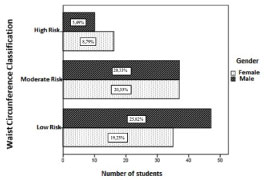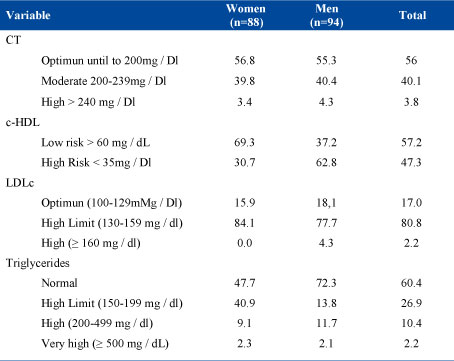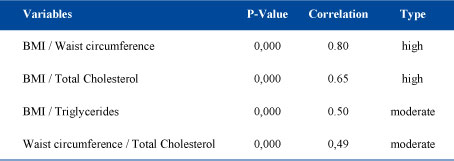E-ISSN: 2346-3414
ORIGINAL ARTICLE
Relationship between Anthropometric Parameters and Lipid Profiles in University Students from Popayán (Cauca, Colombia)
Relación de parámetros antropométricos con el perfil lipídico en jóvenes universitarios de Popayán en Cauca, Colombia
Relação de parâmetros antropométricos com o perfil lipídico em universitarios de Popayán em Cauca, Colômbia
Nancy Janneth Molano-Tobar1, Andrés Felipe Villaquiran-Hurtado2, María del Mar Meza-Cabrera3
1Universidad del Cauca, Departamento de Educación Física, Recreación y Deporte, Popayán, Colombia, E-mail najamoto@unicauca.edu.co Orcid https://orcid.org/0000-0003-1953-4101
2Universidad del Cauca, Departamento de Fisioterapia, Popayán, Colombia, E-mail avillaquiran@unicauca.edu.co Orcid https://orcid.org/0000-0002-6156-6425
3Universidad del Cauca, Departamento de Ciencias Quirúrgicas, Popayán, Colombia, mariadelmar@unicauca.edu.co Orcid https://orcid.org/0000-0001-8273-6529
History
Receibed: Novbre 26th, 2019
Accepted: March 20th, 2020
How to cite this article: Molano-Tobar Nancy Janneth, Villaquiran-Hurtado Andrés Felipe, Meza-Cabrera María del Mar. Relationship between Anthropometric Parameters and Lipid Profiles in University Students from Popayán (Cauca, Colombia). Revista Cuidarte. 2020; 11(2): e1079. http://dx.doi.org/10.15649/cuidarte.1079
![]() Atribución 4.0 Internacional (CC BY 4.0)
Atribución 4.0 Internacional (CC BY 4.0)
Abstract
Introduction: Overweight and obesity are pathologies that are increasing every day. This study was aimed to determine the relationship between anthropometric variables and lipid profiles in a sample of young university students, which leads to taking future prevention actions. Materials and Methods: A descriptive correlational study was conducted with a sample of 182 university students (88 women and 94 men), whose anthropometric variables and lipid profiles were evaluated. Data were analyzed using the SPSS Statistics 20 software. The sample distribution was analyzed using the Kolmogorov-Smirnov normality test. Results were expressed as mean ± standard deviation or percentage, as applicable. Significance was established under the Pearson’s correlation coefficient with p ≤0.05 value. Partial correlations were used to evaluate the relationship between each of the anthropometric risk indices and lipid profile values. Results: 46.7% of the population were overweight classifies as low-risk for waist circumference (45.1%), finding that the body adiposity index was healthy for their age in 64.5% of the participants. As for lipid profile, normal values for triglycerides were found in 60.4% of the participants and optimal values for total cholesterol in 56%. Correlational analysis with a significance of p≤0.005 was positive for gender with anthropometric variables such as Body Mass Index and waist circumference. Discussion: Anthropometric characteristics are closely related to the lipid profile behavior, as shown in this study, and the different research studies conducted with university students. Conclusions: Anthropometric variables are positively related to the gender of university students, finding an association between total cholesterol and triglycerides, which indicates a health risk factor.
Key words: Youth; Obesity; Cholesterol; Triglycerides
Resumen
Introducción: El sobrepeso y la obesidad son patologías que se incrementan día a día. El objetivo de este estudio fue determinar la relación de los parámetros antropométricos con el perfil lipídico en una muestra de jóvenes universitarios, que permitiría acciones de prevención futura. Materiales y Métodos: Se realizó un estudio descriptivo y correlacional con una muestra de 182 jóvenes universitarios distribuidos en 88 mujeres y 94 hombres, a los que se les evaluó variables antropométricas y perfil lipídico. Resultados: El 46.7% de la población presentó sobrepeso con una clasificación de riesgo bajo (45,1%) para el perímetro de cintura y se encontró que el índice de adiposidad corporal fue saludable para su edad en 64,5%. Respecto al perfil lipídico, se encontraron valores normales para triglicéridos en el 60,4% de la población y valores óptimos de colesterol total en el 56%. El análisis correlacional con una significancia de p≤0,005 fue positivo para sexo con variables antropométricas como el Índice de Masa Corporal y perímetro de cintura. Discusión: Las características antropométricas están estrechamente relacionadas con el comportamiento del perfil lipídico, como lo muestra el presente estudio y las diferentes investigaciones realizadas con estudiantes universitarios. Conclusiones: Las variables antropométricas se relacionan positivamente con el género de los estudiantes universitarios, en las que se encontró una asociación con valores de colesterol total y triglicéridos lo que indica factor de riesgo en salud.
Palabras clave: Jóvenes; Obesidad; Colesterol; Triglicéridos
Resumo
Objetivo: O sobrepeso e a obesidade são patologias que aumentam dia a dia. O objetivo deste estudo é determinar a relação dos parâmetros antropométricos com o perfil lipídico em uma amostra de universitários, o que permitiria futuras ações de prevenção. Materiais e Método: Estudo descritivo correlacional com uma amostra de 182 alunos universitários distribuídos em 88 mulheres e 94 homens, nos quais foram avaliados variáveis antropométricas e perfil lipídico. Resultados: O 46,7% da população estava com excesso de peso, com uma classificação de risco baixo (45,1%) para a circunferência da cintura, constatando que o índice de adiposidade corporal era saudável para a idade em 64,5%. Em relação ao perfil lipídico, valores normais de triglicerídeos foram encontrados em 60,4% da população e valores ótimos de colesterol total em 56%. A análise de correlação com significância de p≤0,005 foi positiva para sexo com variáveis antropométricas, como o Índice de Massa Corporal e a circunferência da cintura. Discussão: As características antropométricas estão intimamente relacionadas ao comportamento do perfil lipídico, como mostra o presente estudo e a diferentes pesquisas realizadas em estudantes universitários. Conclusões: As variáveis antropométricas estão positivamente relacionadas ao sexo de alunos universitários, encontrando uma associação com valores de colesterol total e triglicerídeos, e indicando um fator de risco para a saúde.
Palavras chave: Jovens; Obesidade; Colesterol; Triglicerídeos
INTRODUCTION
Noncommunicable diseases (NCDs) are also known as chronic diseases that are mainly caused by unhealthy lifestyles1. More than 15 million preventable deaths worldwide are prematurely caused in people between 30 to 69 years of age. These deaths are preventable provided that the risk factors associated with the onset of these diseases are reduced such as alcohol abuse, physical inactivity, smoking, high intake of salt and sodium, and increased overweight and obesity2,3.
Metabolic risk factors include increased blood fat levels, overweight, and obesity, which have been linked to the early onset of cardiovascular diseases, insulin resistance, hypertension, and metabolic syndrome4,5. In clinical terms, overweight and obesity lead to increased values in triglycerides, low-density lipoprotein cholesterol (LDLc) and decreased levels in high-density lipoprotein cholesterol (HDLc), all which constitute the lipid profile6.
Most of these diseases occur in the adult age7. However, the detection of risk factors in young people is higher. Low levels of physical activity and unhealthy eating habits in young people are associated with a metabolic imbalance of fat and glucose, resulting in cardiovascular and metabolic disease occurrence8.
University years can bring negative lifestyle changes, which may be due to the lack of family support and the lack of promotion of healthy habits in social and educational centers9. Another reason that can explain this phenomenon is related to the change from secondary education to university life10, which entails the adaptation of new standards to a different academic environment as well as social and economic changes11.
Unhealthy lifestyles are characterized by the consumption of high-calorie fast food and processed food, increased alcohol abuse and smoking, and high levels of stress7. These actions particularly lead to greater vulnerability and susceptibility to cardiovascular diseases12.
Then, it is necessary to determine the relationship between anthropometric parameters and lipid profiles in university students to guide and implement programs that promote healthy lifestyles and the prevention of cardiometabolic risk factors in the university context.
MATERIALS AND METHODS
A descriptive correlational cross-sectional study was conducted using a convenience sample of 182 students from Higher Education Institutions (HEI) enrolled in the Physical Education, Recreation and Sports degree between July and December 2018, who were asked to voluntarily participate and were told the objectives of this research.
Inclusion criteria: being active during the 2018 academic term. Exclusion criteria: clinical diagnosis of physical or mental disability, non-communicable diseases, autoimmune diseases, cancer, viral diseases and/or pregnancy.
The assessment was carried out at the HEI’s laboratory for functional and fitness assessment by trained personnel, who conducted a survey to collect preliminary information and select the sample according to the inclusion criteria. Afterward, phone calls were made to the selected students to apply the different assessment and measurement variables of the study.
To evaluate anthropometric variables, the recommendations of the International Society for the Advancement of Kinanthropometry (ISAK) were used as a reference13. For weight and size measurements, the Detecto mechanical scale (Ref RGTA-200) was used having an accuracy of 0.1 cm and a capacity of 200kg. Body Mass Index (BMI) was measured by grouping the data according to the World Health Organization (WHO) guidelines14. For waist circumference (WC), WHO specifications were used, taking as a midpoint the area between the rib cage and the iliac crest15. Moreover, the equation proposed by Bergman et al16 was applied to determine the body fat percentage (BFP):
BFP = [(waist circumference in cm) / ((height in m) 1.5) -18)]
To determine lipid profiles, a standardized clinical laboratory was contacted for blood tests. Participants were instructed to fast for 8-10 hours. The results were presented at the cutoff points of each evaluated variable according to the WHO criteria for Adult Treatment Panel (ATP III)17.
Data were analyzed using the Statistical Package for Social Science® software, version 20 (SPSS, Chicago, IL, USA). The sample distribution was analyzed using the Kolmogorov-Smirnov normality test. The results were expressed as mean ± standard deviation (SD) or percentage, as applicable. Significance was established under the Pearson’s correlation coefficient with p ≤0.05 value. Partial correlations were used to evaluate the relationship between each of the risk anthropometric indices and lipid profile values.
For the study, the Declaration of Helsinki issued by the World American Association (WAA) was used as a reference, in addition to the resolution 8430 of the Colombian Ministry of Health in which scientific and administrative models are established for health research and research involving human beings. The study was also endorsed by the Ethics Committee of the Faculty of Exact Sciences and Education of the University of Cauca18,19. Under the principle of autonomy, the population accepted to participate voluntarily by signing the informed consent form.
RESULTS
The sample was composed of 88 women and 94 men who had an average age of 22.05 ± 3.327 years old, living in areas classified as socioeconomic status 2 and 3 and having basic healthcare services that are specific to Colombia. Table 1.
Table 1. Descriptions of anthropometric variables by sex. M ± DE

Source: Own authorship
Waist circumference showed low risk with 45.05% and a moderate percentage of high-risk classification, as shown in Figure 1.

Figure 1. Waist circumference distribution by sex
Source: Own authorship
Body Adiposity Index was 21.91 ± 7.34, which indicates that health parameters match with gender values, showing a higher health prevalence in men (36.81%) than in women (28.02%).
In the population, the mean values of the lipid profile were observed, demonstrating significance for gender, as shown in Table 2.
Table 2. Shows lipid profile descriptive analysis results, representing normal values

SD: Standard Deviation; TC: Total Cholesterol; HDL: High-Density Lipoprotein; LDL-C: Low-Density Lipoprotein Cholesterol. Source: Own authorship
According to the lipid profile classification, women were at high risk of chronic non-communicable diseases. Table 3.
Table 3. Percentage of risk cases regarding lipid profile.

Source: Own authorship
As shown in Table 4, when analyzing Pearson’s correlation of p≤0.05, the high and moderate correlation variables can be estimated, showing that some anthropometric parameters are associated with lipid profiles.
Table 4. Pearson’s correlation analysis.

Source: Own authorship
DISCUSSION
A large percentage of university students were found to be overweight in the sample taken. In a sample of university male students, Al-Sejari found that more than half of the students were overweight20. In addition, Pengpid and Peltzer reported that 37.5% of the students were above normal weight, although this value is below the findings of this study21. Previously reported data may be associated with the transition between youth and adulthood in college students, resulting in major lifestyle changes (diet, physical activity, stress, sleep), a key step in the adoption of weight-gaining behaviors6, which lead to the early onset of cardiovascular diseases22.
Regarding BMI differences between men and women in this study, women were found to be more overweight compared to men. Pengpid and Peltzer reported different data showing that 28% of men were overweight or obese while just 18% of women were overweight23. Similarly, in a study conducted at a Slovakian university, men showed a higher BMI compared to women. The authors of this research stated that this difference may be caused by careless eating, larger food portions, and higher consumption of alcohol and cigarettes among men24.
In terms of waist circumference, university students were found to be at moderate risk. Morales et al., found increased waist circumference in Chilean university students, suggesting abdominal obesity in this population25. Excessive abdominal fat has been linked to increased insulin resistance, low HDL, high triglycerides, and increased blood pressure26. In addition, anthropometric measures may be more accurate than BMI as a body fat indicator27.
Moreover, the Body Fat Percentage (BFP), which was measured based on the relationship between the hip circumference and height and used as an indicator of obesity and cardiovascular risk28, showed normal parameters in the sample evaluated. González-Ruíz, Correa-Bautista, and Ramirez-Velez state that BFP is a simple marker to predict fat percentage as they found in their study with 204 men from the educational sector in Bogotá. However, discrepancies between the BMI and BFP were also found at 12.5% above the rate, suggesting the need to confirm the results with other research29.
Metabolic syndrome is a disease characterized by high LDL, low HDL, high blood pressure, central obesity, and prediabetes. An early diagnosis allows making appropriate decisions to mitigate the risk of coronary heart disease and type 2 diabetes mellitus. Early detection of dyslipidemia allows timely and appropriate action to prevent non-communicable diseases30. In this study, lipid profile values reported a low percentage of total cholesterol in students with hypercholesterolemia, although 40% had moderate levels. In contrast, 21% of nutrition students in Santa Fé, Argentina presented hypercholesterolemia, which is a higher result compared to this research7.
A high percentage of LDL levels was found in men, probably related to unhealthy eating and sedentary lifestyle25, smoking and increased abdominal girth8. In addition, HDL showed a high-risk result with low blood values in the student population31. In a study conducted at an Ecuadorian university between 2014 and 2015, HDL showed alterations in 39.7% of women and 18.2% of men. This study also reported that 1 out of every 4 students had lipid profile alterations32, results that are similar to those in this study, all related to the risk factor for cardiovascular disease.
There is a close association between anthropometric characteristics and lipid profiles, e.g., overweight students having higher levels of triglycerides, HDL and cholestero16. Sedentary young people with higher BMI had higher levels of LDL, triglycerides, total cholesterol, and lower HDL levels8. All these determine the importance of adopting measures to promote healthy lifestyles.
The relationship between lipid profile and anthropometric variables was evaluated in this paper to provide knowledge about risk factors for noncommunicable diseases in university students. This study leads to replication in other universities to implement healthy decisions in favor of university students.
As a limiting factor, the study may include a larger sample with students from other degrees for more comprehensive research and also involve assessment of lifestyle and physical activity levels to correlate it with anthropometric data and metabolic behaviors.
This research involves new research related to cardiometabolic risk factors among university students across the country in order to take action to mitigate the occurrence of NCDs during university time and make further decisions for the promotion of healthy lifestyles.
CONCLUSIONS
In this study, the participating university students were overweight in relation to their sex and lipid profile alterations. Lipid profile is an indicator for determining cardiometabolic risk. There is a relationship between anthropometric parameters and lipid profile that also shows a relationship with increased BMI, triglycerides, and total cholesterol. All these results lead to implement collective intervention plans that promote physical activity, adequate nutrition and other healthy behaviors associated with lifestyle and modifiable risk factors for chronic noncommunicable diseases.
Source of Funding: None.
Acknowledgements We would like to express our gratitude to the University of Cauca for its support in this research.
Conflict of Interest: None.
REFERENCES